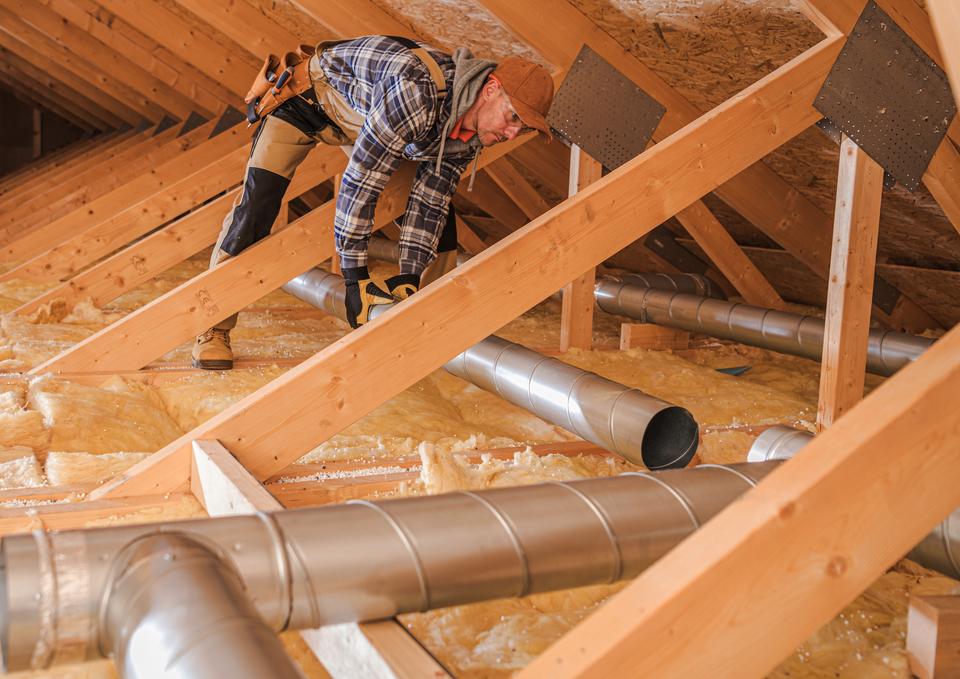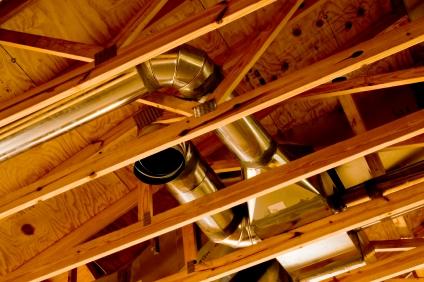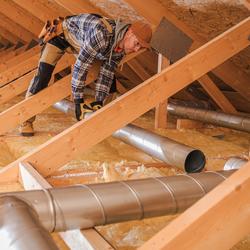How Much Does it Cost to Install New Ductwork in a Tucson Home?

Air quality expert installing ductwork
Lots of homeowners waste money on their energy bills due to lousy ductwork. If you’re looking to update or install new ductwork, it will cost between $10 and $60+/foot on average, with most people in Tucson paying around $25/foot.
Several aspects go into the cost:
No one likes to be surprised by a hefty home maintenance bill, so let’s talk about each of these aspects in greater detail to help you understand what this could mean for you.
Ready for a personalized ductwork estimate?
When you work with Advantage Air Mechanical, you’re working with a team that even other HVAC contractors in Tucson trust for their custom ductwork needs.
Type of Installation
One of the most significant factors influencing the cost of new ductwork is the type of installation—the complexity, ductwork material, and length of ductwork can vary significantly between different types. We’ll compare the costs of several types below:
- Residential vs. commercial ductwork
- New build vs. existing home ductwork
- Duct replacement vs. new ductwork
Residential vs. Commercial Ductwork
Commercial ductwork is usually more expensive than residential ductwork because the length of runs is typically more extended, and manufacturers create the ducts with more expensive materials. We’ll discuss how duct materials and the length of runs impact ductwork cost in the sections below.
New Build vs. Existing Home Ductwork
It’s typically more expensive to install new ductwork in an existing home than in a new build. A home designed with the appropriate infrastructure and design to incorporate the necessary ductwork can save you money on the cost of home modifications (e.g., cutting holes in the walls for vents) and on your energy bills.
One significant cost-saving benefit to installing ductwork in a new build is that air quality experts can design ducts to run through “conditioned spaces”—areas of the home that require heating or cooling. No matter how well they’re insulated, ducts inevitably leak some heated or cooled air into the room they run through. That’s why it’s beneficial to have ducts run through conditioned spaces—when air leaks into conditioned spaces, there’s no loss of energy because those rooms were going to be heated/cooled anyways.
When installing ductwork in an existing home, the options are more limited for where the ducts can go. Attics, crawlspaces, and basements are popular choices for ductwork because you can place ducts in them without home modifications, such as adding drywall or dropped ceilings to hide the ducts.
However, the U.S. Department of Energy estimates that ducts in attics and crawl spaces lose 25–40% of the energy that passes through them. So, you're essentially paying to waste heated or cooled air when you place ductwork in "unconditioned spaces," AKA areas that would typically not be heated or cooled.
Duct Replacement vs. New Ductwork
In general, duct replacement is more expensive than installing new ductwork in a new build but less expensive than installing new ductwork in an existing home. You can think of it like this:
$ New Build Ductwork < $$ Duct Replacement < $$$ Existing Home Ductwork
Duct replacement is more expensive than installing ductwork in a new build because removing the existing ductwork is an additional cost. However, duct replacement in an existing home means that home modifications are likely not necessary, making it a less expensive process than installing new ductwork in an existing home.
Length of Ductwork Runs
The more duct material you need, the more expensive your ductwork installation is going to be. While the amount of duct material can correlate with the square footage of your home, other factors play an important role in determining the length of ductwork runs needed, including:
- Home layout
- Size of your ducts
- Climate
Each home is unique, which is why we perform on-site duct sizing calculations for each duct installation job we perform. To determine how much ductwork your home needs, schedule an in-home visit with one of our HVAC technicians.
Access to the Ducts
Ducts installed in a hard-to-reach area, such as a crawl space, are more expensive to install than ducts in open spaces. Ducts in tight places are more difficult for technicians to service, resulting in increased labor costs.
Duct Material
When it comes to the material that makes up your ducts, several different options are available that vary in price and insulation. Generally, more flexible ductwork (polyester and aluminum) is less expensive but tends to be more poorly insulated and less energy efficient. More rigid ductwork (fiberglass and galvanized steel) is more costly to install but more insulated. Most ductwork installations require some combination of flexible and rigid ductwork to accommodate the size and shape of the ductwork needed.
With the proper care and maintenance, ductwork can last around 25 years, and rigid ducts typically last longer than flexible ducts. Because your choice of ductwork material can depend on many factors, it can be valuable to get a professional opinion before deciding which option is suitable for your home.

Hire Advantage Air Mechanical to design, fabricate, and install your ductwork
Advantage Air Mechanical is your one-stop shop for custom ductwork.
Advantage Air Mechanical's ductwork installations are unique because we design and fabricate custom architectural ductwork in our in-house metal shop—you can even stop by the shop and see your ductwork's build progress if you want to!
Because we can build your ductwork ourselves, we can complete your ductwork installation quicker than our competitors, saving you time and money. Once we build your ductwork, we'll install it in your Tucson home over 1–2 days.
To learn more, give us a call or schedule your free in-home estimate today!
